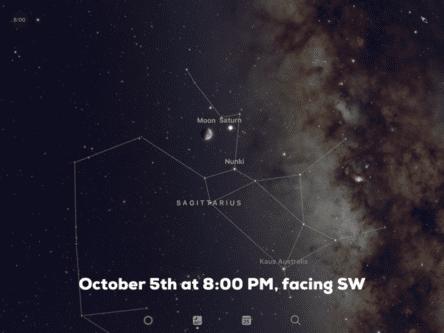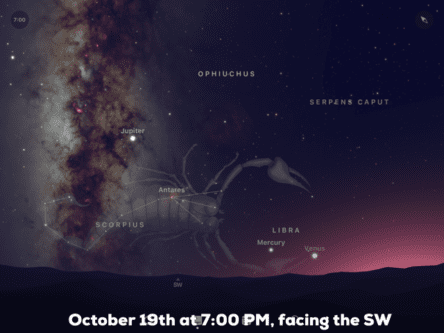Highlights of the October Sky 2019
• OCT 1 – NASA began operations on this date back in 1958
• OCT 3 The waxing crescent moon and Jupiter form a lovely conjunction in the sky tonight.
• OCT 4 – Sputnik became the first artificial satellite on this date back in 1957, ushering in the Space Race.

• OCT 5 – The first quarter moon and Saturn pair up tonight in a lovely conjunction.
Today is both Fall National Astronomy Day and International Observe The Moon Night. Join members of the Central Arkansas Astronomical Society at the Pinnacle Mountain State Park visitor center for a lunar observing star party. Enjoy great telescope views of the moon and the planets Jupiter and Saturn this evening from 7:00 Pm to 10:00 PM.
• OCT 9 – In 1604, Kepler’s Supernova was seen by European, Arabic, Chinese, and Korean astronomers. Seen in the constellation of Ophiuchus, this supernova is an example of what astronomers call a Type Ia supernova. Type Ia supernovas involve a binary pair of stars with one of the pair being a white dwarf, the compact core of a dead star. As the pair orbit around one another, the white dwarf leaches material from its companion. This stolen material, pushes the white dwarf past a certain mass threshold, triggering a runaway nuclear reaction, culminating in an explosion that obliterates the star. Because Type Ia supernovas all have a very similar intrinsic brightness, they can be used by astronomers as “standard candles” to calculate distances across the universe.
• OCT 10 – At 1:29 PM CDT, the moon is at apogee, its most distant point in its orbit around the Earth for the month, at a distance of 252,214 miles.
• OCT 13 – The moon is at full phase tonight.

• OCT 19 Mercury is at its greatest eastern elongation, being 25 degrees east of the Sun. Look for it and the planet Venus right at sunset. Venus, the brighter of the two will stand out pretty clearly, but you will probably need binoculars to pick our nearby Mercury. Make sure that the sun is below the horizon before using optical aid to see them!
• OCT 21/22 – The modest (10 to 20 meteors per hour) Orionid Meteor Shower peaks tonight. The radiant for the shower is located in the constellation of Orion, which rises above the eastern horizon at around 11:30 PM, two hours before the waning crescent moon. So, while the moon’s light will somewhat hamper the view, you can still likely see a few bright meteors if you get yourself to a dark sky locale. To find a site, head over to the Arkansas Natural Sky Association website: http://darkskyarkansas.com
• OCT 24 – The first photo of the Earth taken from space was made on this day in 1946
• OCT 26 – Over the next two weeks, look for the zodiacal light in the eastern pre-dawn sky. The zodiacal light is sunlight being reflected off of grains of interplanetary dust, the source of which is likely comets. The zodiacal light takes the form of a faint, eerie glow in the shape of a cone or pyramid. It’s a very subtle effect but obvious enough that many people call it “the false dawn”. You will need dark skies to see it.
• OCT 27 – The moon is now at new phase and cannot be seen as it lies in between us and the Sun.
• OCT 28 – The planet Uranus is at opposition. Opposition means that, from an observational standpoint, the planet is positioned upon the sky in between the Earth and the Sun. At opposition, a planet rises right around sunset, reaches its highest point in the sky at midnight, and then sets in the west at sunrise. You can see Uranus (pronounced: Your-un-us) with binoculars or small telescope as a small green disc. Use a sky map from an astronomy magazine or a good astronomy app to help locate it. Scan the area first with binoculars in order to find it before you use a scope.
• OCT 29 – Right at sunset, look to the west and see if you can spot a very thin waxing crescent moon just above Venus and Mercury.
